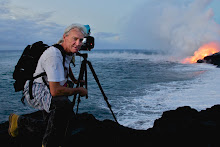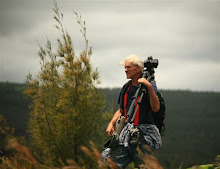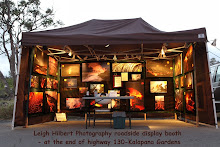 Above zoomed in and below, a 16mm wide view showing the many stars above the lava we have been seeing on these clear nights: Photos taken from the Kalapana lava viewing road the last two nights.
Above zoomed in and below, a 16mm wide view showing the many stars above the lava we have been seeing on these clear nights: Photos taken from the Kalapana lava viewing road the last two nights. Big Dipper among the many stars(Click on the images to open a larger view window)
Big Dipper among the many stars(Click on the images to open a larger view window)This surface lava is being fed by lava tubes from the TEB eruption site far above the edge of the pali where the lava is resurfacing as A`a and pahoehoe breakouts from the 1900 down to at least the 1000-foot elevation.
Deflation/Inflation, or DI events of the Kilauea magma chambers are being recorded by USGS/HVO crater monitors and currently the graphs are showing some strong inflation, which likely is manifesting on the pali breakout by the brighter and more rapid advancement of surface lava:

The Halema’uma’u crater is also being strongly affected by the rise in magma pressure below it and this is seen visibly by the lighter plume rising from the craters eruptive pit vent, as shown by the screen-capture below and as also described on the USGS/HVO update page this morning. They say, “… there was a brief high stand of lava last night between 6:40 and 7:40 pm last night and another started at 6:45 am this morning and has not yet completed”. In past report updates by them they describe how a ‘high stand of lava’, meaning molten lava within the pit vent rises up inside the vent column, causes less sulfur dioxide gas, and other gasses, to be released, creating a thinner visible plume:

There are no active lava breakouts on coastal flats and no ocean entry lava at this time.
I will update these blog postings next when there are some significant changes or newsworthy reports to offer you :)
Active lava viewing prospects for the public:
1) The Halema’uma’u crater has been degassing sulfur dioxide fumes by day and glowing strongly at times after dark from lava deep within the craters pit vent. The broiling molten lava moves up and down inside this massive eruptive vent by hundreds of feet at times, in kind of a pistoning action. This raising and lowering of lava has the potential to breach the floor of the crater and likely will do so in the future. Great views of this impressive crater are from the Jaggar Museum balcony within the Hawaii Volcanoes National Park, depending on the weather; and the park is open to the public 24 hours a day with a nominal entrance fee by day..
2) Coastal viewing: Three to four hundred visitors seeking to witness lava activity have been arriving daily at the Hawaii County Kalapana viewing area: The viewing area is essentially the last mile of paved road on highway 130; the end of which is the same location where lava came onto the highway on May 5th, 2010. A 1/2- mile walk down the road gives views of the lava fuming/degassing where it is coming down the distant pali during the day. After dark lava glow can easily be seen in two or three places high atop the mountain slopes, which is becoming a little brighter each night as it works further down the mountain towards the coastal flats and highway 130..
Official viewing hours are from 2:00 PM until around 9/9:30 PM - everyday, with last car allowed in at 8:00 PM. On site are security personnel and a few port-o-potties at both the parking lot and at the end of the road. Vendors occasionally have drinking water and flashlights but it is best to bring both these things with you and also some decent walking shoes. This end of highway 130 is open to all traffic on all other hours.










No comments:
Post a Comment